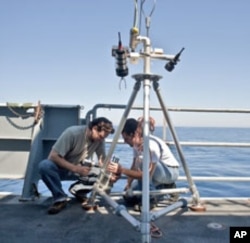An independent expert estimates that 4.4 million barrels of oil spilled into the Gulf of Mexico after a deep water well ruptured in April.
Earlier this week, BP confirmed that the broken well had been permanently sealed.
Since the spill, official estimates of how much oil was released kept changing, from 1,000 barrels a day to 5,000, then to 12,000, then 19,000, and the numbers continued to rise.
A new study reported in the on-line edition of the journal Science is the first independent measure how big that spill actually was. Lead author Timothy Crone says he questioned the numbers, and decided that an independent assessment was needed.
"I thought it was my responsibility to provide as much information about this flow as I could."
Massive spill
Crone, a marine geophysicist at Columbia University's Lamont-Doherty Earth Observatory, was well positioned to do so. He studies the flow of natural deep-sea vents that spew super-heated jets of mineral-laden water which, he says, are similar to the flow from the broken oil riser. "[They are] very similar optically and similar in terms of the fluid dynamics as the flows that I had been studying previously and so it was just kind of an obvious fit to apply the techniques to this oil flow."
Crone's technique uses high resolution video from underwater cameras to track and analyze the motion of turbulent billows and flows from the extremely hot cracks and holes in the seafloor. He's describes the method is non-invasive.
"That means you don't have to put anything in the flow. You don't have to disturb it. You don't have to engineer your device in order to withstand the temperatures that these things have."
Crone based his oil spill estimates on a few high resolution video clips, not the webcam video that was publicly available. His calculations showed that between 56,000 and 68,000 barrels of oil per day spilled into the Gulf of Mexico, adding up to an estimated 4.4 million barrels, a number that's close to the most recent consensus by a team of government advisors. Crone says his study is proof that the video technique can work. But he adds that more research needs to be done.
"The formal uncertainties of my estimates are plus or minus 20 percent. It's difficult to say much about the temporal variability because we just don't have enough video and haven't analyzed enough video, but hopefully we can do that in the future. My guess is that the clips analyzed were fairly representative."
Lingering effects
Many experts say up to half the spilled oil remains in the environment and is slowing degrading. But its effects linger.
National Wildlife Federation Senior Scientist Doug Inkley fears that some habitats may have been irrevocably altered. So, getting the numbers right, he says, makes a huge difference in charting the appropriate course of action for years to come. "That way you know how many resources to deploy and where to deploy them. It's also extremely important for scientists to know this. They have to know how much oil was spilled and where it was distributed in order to understand what those impacts were."
Inkley notes the hydro-gases that escaped with the spewing oil must also be accounted for. "In fact the amount of hydro-carbon gases released, at least in weight, is equivalent to another 50 percent of the oil that was actually spilled. That too was released into the environment and has saturated the water and it has an impact on the fish and wildlife in the ecosystems."
Inkley says those gases also contribute to global warming. He says the true scale and scope of the Gulf oil disaster underscore the risky nature of deep-ocean oil drilling and the need to move more aggressively toward a cleaner, renewable-energy future. Timothy Crone's work was published in the September 23 online edition of the journal Science.













